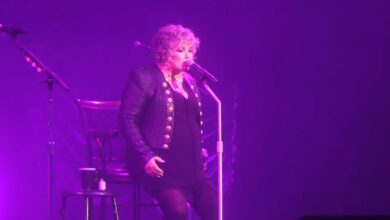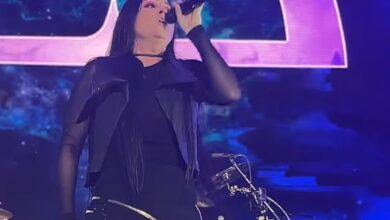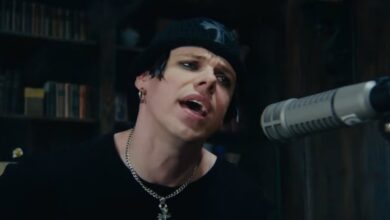Limp Bizkit Defy the Storm: Fred Durst Leads a Thunderous Rain-Soaked Show in Philadelphia
It started with a sky that wouldn’t play nice. By late afternoon over South Philly, the clouds had thickened like a curtain call, the kind that makes stadium crews tap their clipboards and fans start eyeing ponchos. Limp Bizkit took it as a dare. As thousands flowed through the concourses of Lincoln Financial Field—the same vast bowl that hosts football thunder and touring giants—the first rumbles of weather set the tone. People joked about “stadium showers.” Then they heard the house mix swell and saw the stage lights sharpen through the mist. The night was going to happen, rain or not. And in a weird way, the rain made it feel bigger, like the city itself was joining the chorus.
“My Way” landed like a flare in the wet dusk. It’s a song that begs for shared catharsis, and in the first minute, you could sense the crowd aligning with the band’s tempo, building a communal umbrella no cloud could puncture. Phones shot upward into the drizzle; the opening riff skittered across the water pooling on plastic seats. Fred Durst leaned into the weather, the way veteran frontmen do—less fighting the elements than yoking them. The track’s refrain turned into a declaration of intent: we’ll do this our way, and tonight that means embracing the storm.
By “Nookie,” the field felt like a festival in a car wash. Puddles became rhythm sections, beating time beneath stomping sneakers. You could see it in the faces on the lower bowl: people who had come for Metallica’s M72 spectacle realizing they were in the middle of a classic “you had to be there” opener. Limp Bizkit wasn’t just surviving the conditions—they were shaping them into part of the show’s narrative, the kind of serendipity you can’t program on a tour grid.
Then “Rollin’ (Air Raid Vehicle)” lived up to its name, because at that exact moment the heavens decided to upgrade from “steady sprinkle” to “industrial rinse cycle.” If you thought a stadium can’t dance in a downpour, you weren’t in Philadelphia that night. Entire sections waved arms in hypnotic unison, rainwater flying off jacket sleeves like stage sparkles. It’s one of those songs that makes strangers high-five for no reason except the beat told them to. The stadium cameras caught it all: rows of fans bouncing, a gridiron turned slip-n-slide, a city having the time of its life in defiance of common sense.
And then came the moment that sealed the legend: “Break Stuff” in monsoon conditions. The title alone sounds like a weather forecast when the radar is red. Video angles from the pit tell the story—the downpour growing to sheets, the crowd’s roar consolidating into a single, gleeful shout, the band charging through like it was sunny and 72. You couldn’t script better punk theatre: the song’s primal stomp, the zero-visibility chaos, the shared grin that passed through the lower bowl like a ripple. Everyone got soaked, and nobody cared. It was the kind of chaos that cleans you out.
Of course, rain does what rain does—to the gear as much as the people. At one point, DJ Lethal’s rig balked, a casualty of the airborne Atlantic falling straight onto the electronics. Instead of deflating the set, the glitch became a punchline and a rallying point—proof that this wasn’t a sterile, climate-controlled pageant. It was rock and roll in the elements, the kind of live-wire risk that makes stadiums feel intimate. The fix came, the groove snapped back, and the crowd cheered like a home team had recovered a fumble.
Setlist junkies had plenty to chew on. The compact blast of “My Way,” “Nookie,” “Rollin’,” and “Break Stuff” felt engineered for maximum contact—four haymakers in quick succession—yet the flow never felt rushed. It was more like the band had mapped the audience’s weather patience and written a meteorological symphony: open the valves, get everyone singing, throw gasoline on the tempo, then slam the anthem that sends the place into orbit. Shaky phone videos from a hundred vantage points confirm the same arc—tight, punchy, euphoric.
If you want to understand how nights like this happen, consider the ecosystem. This was Night 1 of Metallica’s M72 “No Repeat Weekend,” a traveling two-night city takeover designed like a mini-festival. Limp Bizkit weren’t just an opener—they were the spark plug for a machine built to run hot. The booking choice felt mischievous and perfect: a band that thrives on crowd chemistry dropping into a 60,000-seat bowl primed for catharsis. Rain only intensified the feedback loop, fusing opener and headliner crowds into one loud, wet tribe.
Lincoln Financial Field, for its part, turned into a character. Stadiums can be antiseptic if the night doesn’t kick. But when the weather joins the show, their massive architecture amplifies feeling—the roofless bowl becomes a mouth, the terraces a choir. Even the slick concrete walkways seemed to pulse as fans moved en masse from stands to concessions to back again, treating each song break like a halftime sprint before the next blitz. Somewhere in that churn, you got the sense that the ordinary rules—about comfort, dryness, schedule—had been suspended.
There’s also the Philadelphia factor. This is a sports town that loves grit, and a music town that rewards nerve. A lesser band might have bargained with the conditions—trim a song, temper a breakdown, play it safe. Limp Bizkit slammed the gas. The more the rain hammered, the looser and more communal the place felt, like South Philly had collectively decided to celebrate the absurdity. The cameras caught drenched smiles, people laughing at the sky, the kind of civic shrug that says: you picked the wrong city to try and wash out.
What makes the performance linger isn’t just the spectacle; it’s how the band and crowd co-wrote the night. Weather is the oldest special effect, and it’s mercilessly democratic. It drenched the rail-riders and the upper-deck diehards alike. And because everybody was in it together, the music felt bigger, bonded by shared discomfort turned joy. That gives songs like “Rollin’” and “Break Stuff” a different flavor—less swagger for swagger’s sake, more collective therapy session where the punchlines are shouted through raindrops.
You can trace the proof across the internet’s breadcrumb trail: 4K clips from the Snake Pit, wide shots from the 200 level, shakier reels from folks who forgot to dry a lens. None of them are “perfect,” which is precisely the point. The water on the camera glass, the muffled bass in the gusts—that’s the patina of authenticity. Together they reconstruct the frenzy, like a crowd-sourced documentary edited by the weather gods.
And remember, this was just the first half of a city’s two-night metal carnival. Metallica’s M72 design means no repeats between nights, which turns openers into tone-setters and momentum builders. When your prelude ends with 60,000 soaked and smiling, you’ve set a high bar for the headliners to leap. That’s the secret alchemy of a great bill: each band doesn’t just play—they stack conditions that make the next act even more inevitable. On this night, Limp Bizkit stacked them sky-high.
It’s impossible to revisit this show now without a tug of sadness. In October 2025, the band announced that founding bassist Sam Rivers had died at 48. The tributes called him their “heartbeat,” a phrase that sounds sentimental until you hear how central his tone and feel have always been to the group’s thump. Listening back to those Philly clips, you can almost isolate his presence in the way the low end carries through the weather—a steadying hand in a chaotic storm. The loss reframes the memory; the joy of that night now carries a halo.
Rivers’ passing adds a layer of gratitude to that rain-drenched footage. The Philly set reminds you that bands are living organisms, their chemistry hard-won and irreplaceable. The best nights feel both reckless and precise: reckless in how they sprint into the unknown, precise in how the players catch each other when the unknown swings back. If you stood in that stadium—or if you’ve watched the videos since—you’ve felt it: the pulse that runs from drummer to bassist to crowd, braiding a field of strangers into something like a single instrument.
In a world of choreographed tours and pre-baked special effects, what happened on May 23 wasn’t programmable. It was a conversation between a band, a city, and a storm—one that left everyone a little lighter and a lot wetter. Years from now, people will say, “Remember that Philly downpour?” And someone will answer, “Yeah. Limp Bizkit didn’t just play through it. They made it part of the song.” Nights like that don’t just stick to setlists; they stick to memory.
If you measure concerts only by precision, dry weather will always win. If you measure them by story, this one is a champion. You can still hear the crowd surge when the beat drops, still see raindrops exploding in the work-lights, still feel the silly-serious joy of shouting a chorus because that’s what your section is doing. It’s communal nonsense at its most sacred. In the end, the rain didn’t wash anything away. It developed the film.





